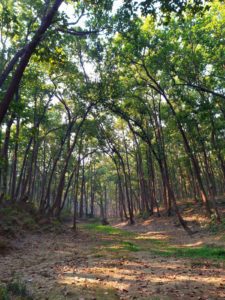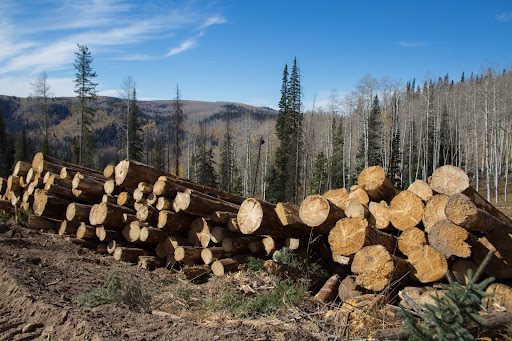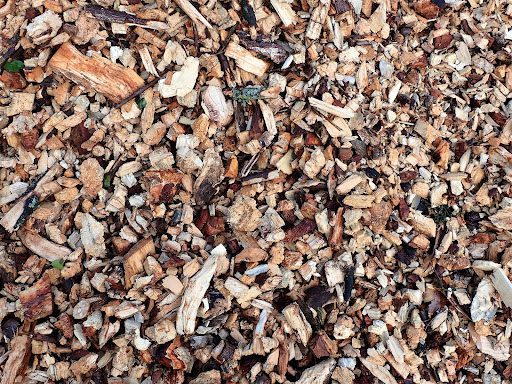When walking through New England woods, it’s easy to think you’re in a permanent patch of nature kept pristine through the ages. The reality is that most of the land in New England was deforested in the colonial period, and most of the forests growing today are relatively young. We clear and regenerate forested land constantly. Understanding why we need to clear land and how we do it helps to illustrate just how robust and vital our forests are.

New England Forest
What Exactly Is Land Clearing?
Land clearing is the process of turning land for commercial, residential, or agricultural use. This often marks a transition from the unbroken wilderness or managed timberland to more developed use. This is different from periodic timber harvests, where timber is allowed to regenerate in preparation for a future harvest, instead being a fundamental change in how the land is used.
The Importance of Land Clearing
Land clearing is the first step for almost any type of development project. From residential communities to industrial processing, supermarkets, restaurants, amusement parks, or just about anything else. Very few of the modern conveniences and necessities we count on can exist without clearing away the trees, brush, rocks, and other natural obstacles to construction. Even many operations focused on natural resources, such as Christmas tree farms or quarries, require first clearing the land out to make work efficient.
Land that’s ready to develop without first being cleared is quite uncommon in New England, where natural forest regeneration rates are quite high. Even land that was used for a purpose like agriculture, light industry, or residential purposes will be reclaimed by the forest in just a few decades if not maintained. This means that if there isn’t readily available land that’s already developed, the only option for new projects is to clear overgrown land.
Approaches to Forested Land Clearing
Depending on the scale of a land clearing project, there are many different approaches that can work.
Grubbing and Hand Clearing For Small-Scale Land Clearing
Grubbing and hand clearing constitute the most basic approach to land clearing. Using hand tools such as chainsaws, machetes, spades, and other tools, it’s possible to clear lightly wooded land. This is only a reasonable approach if you’re trying to remove light plant cover such as saplings, bushes, undergrowth, brush, and relatively small stones. It’s prohibitively difficult to clear larger obstructions.
This approach is best suited for small projects, like clearing space for a shed or reclaiming some land from the edge of your woods for a garden. Larger clearing projects require different approaches or extreme time and effort commitments.
Timber Harvesting As The First Step For Big Land Clearing Projects
Timber harvesting is the process of harvesting mature trees and selling timber for various applications, such as dimensional lumber for building, pulp for paper, woodchips for mulch, and so on. This is at the heart of Day Logging’s expertise.
For heavily wooded tracts of land, some type of tree removal is necessary for clearing land. This can be done with bulldozing, but the trees are significantly damaged and not useable as timber. While the logging process leaves stumps behind, the profit from selling timber helps fund the removal of stumps. While logging isn’t a full solution, it’s a good start for serious land-clearing projects.

Burning As An Alternative Way To Clear Land Quickly
Burning dense vegetation is among the fastest ways to clear flora. Burnt plant matter also offers significant nutrition for the soil and kills most seeds left behind by weeds. It’s safest to first cut down the plants and trees in the area you’re clearing and then burn all the slash in a pile.
Make sure you secure all necessary local permits before engaging in this approach. There’s a significant danger that an untended fire will burn out of control, so make sure you tend the fire and have other safety measures in place, including a hose that can easily reach the fire.
Bulldozing To Get Land Cleared Fast
This is a heavy-duty approach to land clearing. This method is usually associated with larger commercial and residential development projects. Heavy Machinery, such as bulldozers and excavators, can be used to clear obstructions like trees and boulders. Normally, this is coupled with manual grubbing using hand tools to remove smaller obstructions and roots left behind.
The biggest advantage of using heavy machinery is that it can rip out stumps and other large obstructions that are very difficult to deal with by any other means. The problem is that renting machinery and hiring an operator is quite expensive.
The Advantages of Land Clearing With Logging First
As mentioned above, there’s a real risk that heavy machinery will cause damage to trees that have value and can be sold. By logging first, before hiring a company or renting machinery to remove stumps and boulders, you can generate income to offset further costs. There are some further advantages, depending on the nature of your project.
Grinding and Mulching
Grinding or mulching discarded plant matter is one of the most cost-effective ways to clear any remaining detritus after a timber harvest or land-clearing project. It’s also the most cost-effective way to slow the regeneration of plants on recently cleared land. The woodchips generated block sunlight from reaching seeds and plants below them and eventually break down naturally over time, adding nutrition back to the soil.

Help Establishing Roads
While a logging company won’t build a paved road for you, they do require solid logging roads to harvest timber. These logging roads are primitive but can serve as the foundation for a final road or driveway. These logging roads can also help with getting in the heavy machinery needed to remove stumps, such as excavators or tractors. If you need a logging road to access your timber, be sure to talk to your logging contractor about the need in advance, so they can be prepared and contract any necessary help to build the road.
Working WIth the Right Partner To Clear Land
If you want to clear forested land for another use, starting with logging is often the best approach. If your land is in ME or NH, Day Logging can help you clear your land with an appropriate logging operation. Reach out today to learn more about how we can help.
